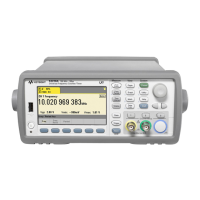Formats and Data Flow 7
Keysight 53220A/53230A User’s Guide 261
When specifying a folder name the current folder is referenced. If a current folder
(MMEM:CDIR) has not been specified and a drive name (INT or USB) is not
included, the default drive ‘INT:’ is referenced. For example:
MMEM:MDIR “dut_2”
creates the folder ‘dut_2’ on the root drive INT.
Following a reset (*RST) or instrument preset (SYSTem:PRESet), the counter
resets the current folder to the root directory on the internal flash file system
("INT:\") .
Creating data files
See “Histograms” or “Trend Charts” and “Data Logging” in Chapter 6 for
information on storing measurement data from the front panel.
The command used to transfer data from reading memory to a file in internal flash
memory or on a USB device (Figure 7-1 and Figure 7-2) is:
MMEMory:STORe:DATA RDG_STORE, “<file>”
<file> is created during execution of the command and the file parameter format
is “[drive:path]<file_name>”. drive is either INT (internal flash memory) or
USB (external memory device). path is an absolute path and folder name. If a
folder is specified, it must have been previously created.
The combination of folder and file name cannot exceed 240 characters, and
cannot contain the characters \ / : * ? “ < > |.
The format of the transferred readings is specified by the file_name extension. If
.csv is specified, the data is stored as comma-separated values (CSV) in one
measurement per line ASCII format. If .dat is specified, the data is stored as REAL
values with little-endian byte order.
The following sequence of commands creates a folder on a USB memory device,
takes a set of frequency measurements, and then creates a file and copies the
measurements to the folder from (volatile) reading memory.

